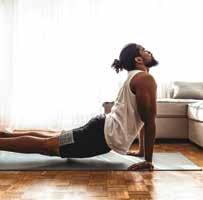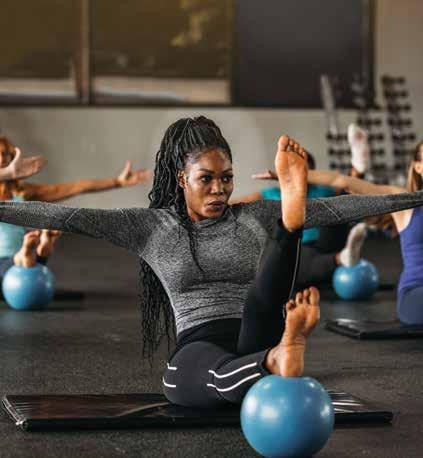
3 minute read
Fitness Tips: Pilates
Fitness Tips
PILATES
By Dylan Roche
“I must be right,” Joseph Pilates, the inventor of his eponymous Pilates exercise routine, is quoted as saying. “Never an aspirin. Never injured a day in my life. The whole country, the whole world, should be doing my exercises. They’d be happier.”
Although Pilates might not be the cure-all its founder perceived it to be, there’s no denying his exercises offer many benefits to those who perform them. Back when Pilates created his program in the early 20th century, it was originally intended as a way of helping professional dancers recover from injury. But over the decades that followed, these conditioning exercises gained popularity with a variety of demographics, from professional athletes all the way down to those just starting a fitness journey.
The idea is simple: Because people tend to use their muscles the same way in most of their regular activities, they can benefit from correcting muscular imbalances, realigning their posture, and strengthening their core through a series of movements and poses. The result is a stronger, more flexible, more toned body with fewer aches and pains.
To the layman, Pilates might look similar to yoga, and they’re not completely wrong—Joseph Pilates practiced yoga himself, and he adapted several of yoga’s poses when creating his exercises. Like yoga, Pilates also emphasizes proper breathing and mindfulness as a person goes through the exercises.
But at their most basic level, yoga and Pilates have their differences. Yoga focuses on postures and alignment; on the other hand, Pilates is about strengthening and stabilizing. Some workout routines combine elements of both yoga and Pilates into routines known as either yogalates or PiYo.
Although you might have seen Pilates done on a special bedlike apparatus called a Reformer, most Pilates exercises require no equipment whatsoever. They can be done on a simple mat using only your bodyweight.
Interested in trying out Pilates at home before seeking out a class at a local gym or studio? Here are three Pilates-inspired movements recommended by the American Council on Exercise

THE SWAN
Perform this Pilates exercise to stretch your spine and strengthen your back. Start by lying on your stomach on the mat. Bend your arms so you can place your hands palmdown by your shoulders. Keep your elbows as close to your sides as you can.
Raise your head and shoulders off the mat, inhaling slowly as you go. Take care you are slow and deliberate—you should be stretching your spine, not performing an inverted crunch motion.
Exhale and lower your head and shoulders back to the mat. Repeat five times, focusing on breathing as you complete each swan.
THE HUNDRED
This basic Pilates move is great for strong abdominal muscles and improving endurance.
Begin by lying on your back. Bend your knees and raise your feet slightly off the floor.
Breathe in as you lift your head and shoulders off the mat. Raise your arms slightly so they are parallel with your core.
Extend your legs and hold them at a 45-degree angle with the ground. Keep your heels together and toes apart.
Vigorously move your arms up and down in a pumping motion. Breathe in as you pump your arms five times, and then breathe out as you pump your arms another five times. This constitutes one set.
Repeat these sets 10 times for a total of 100 pumps. When you’re done, hold your position before slowly bending your knees and lowering your feet back down to the mat. Slowly lower your head and shoulders as well.
SINGLE LEG SPLIT
In addition to building a stronger core, this movement helps improve pelvic stability. Begin by lying on your mat with your legs raised above you at a 90-degree angle. Raise your shoulders slightly off the mat.
Breathe in as you bend your right leg and draw your knee in toward your chest. Hold the back of your thigh to bring your leg as close to your core as possible.
Lower your left leg until it is only a few inches above the floor. Hold this position as you exhale. Inhale as you switch leg positions, bending your left leg and drawing your knee in toward your chest while straightening your right leg and holding it only a few inches above the ground.
Exhale as you hold the position. This constitutes one set.
Perform 20 sets, paying close attention to your breathing as you do them.










